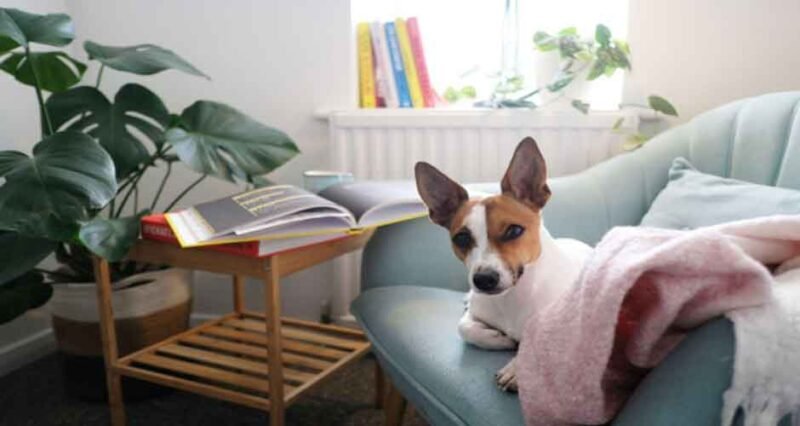
Welcoming dog owners to the concept of tailoring their living space to accommodate their furry companions. Acknowledging the importance of providing a safe, comfortable, and enriching environment for dogs. This article will delve into the nuances of crafting a pet-friendly home that aligns with both your dog’s needs and your lifestyle.
Pet-Proofing Your Home
Identifying and Mitigating Hazards
The first step to creating a pet-friendly home is recognizing potential hazards that may pose a danger to your dog. Cords, toxic plants, and small objects are among the common household items that can be harmful. In a recent article from Happy Pet Deals, they advocated for a thorough inspection of your living space to pinpoint these hazards and offer practical insights on addressing them.
Effective Solutions and Safety Measures
Once potential dangers are identified, implementing safety measures becomes crucial. Safety gates are recommended for restricting access to certain areas, especially where your dog might encounter risks. Containment options, such as playpens or crates, can be helpful in keeping your pet safe during specific situations, like when guests are over or during cleaning sessions.
Choosing Pet-Friendly Furniture and Flooring
Selecting Durable and Easy-to-Clean Materials
Dogs are known for their playful nature and occasional accidents. Choosing pet-friendly furniture and flooring materials that can withstand their activities is essential. Our team emphasizes the use of durable and easy-to-clean materials like leather, microfiber, or synthetic fabrics for furniture. For flooring, hardwood, laminate, or vinyl are recommended due to their resilience against scratches and spills.
Furniture Design that Accommodates Pets
Furniture design should prioritize both aesthetics and functionality. Opt for furniture with removable and washable covers to facilitate cleaning. Avoid materials that attract pet hair or are easily scratched. To discourage scratching behavior, consider incorporating scratching posts or mats near furniture.
Designing a Comfortable Sleeping Area
Creating a Cozy Retreat
Sleep is crucial for a dog’s overall well-being. Providing a comfortable and cozy bed is a priority. Factors like size, age, and sleeping habits should be considered when choosing a bed. Orthopedic beds are recommended for older dogs with joint issues, while puppies may benefit from softer, smaller beds.
Strategic Placement for Tranquility
Where you place your dog’s bed matters. Choose a quiet and peaceful area that offers a sense of security. Avoid high-traffic zones or places with excessive noise. A bedroom corner or a spot near your own sleeping area can create a feeling of closeness while allowing your dog to have their own space.
Feeding and Hydration Station
Designating a Dedicated Eating Zone
Establishing a designated area for feeding is essential for creating a routine and maintaining cleanliness. This area should be easily accessible and away from heavy foot traffic. Consistency in meal placement helps regulate your dog’s eating habits.
Choosing the Right Dishes
When it comes to food and water dishes, practicality and safety are key. Elevated bowls can promote better posture and aid digestion, especially for larger dogs. Stainless steel or ceramic dishes are recommended due to their durability and ease of cleaning. Additionally, keeping the feeding area clean helps prevent the growth of bacteria and pests.
Creating an Indoor Play Area
Setting Up Engaging Play Spaces
Indoor play areas are essential for keeping your dog mentally stimulated and physically active, especially during inclement weather. Identify spaces that allow for movement and exploration. Clear away obstacles that could hinder playtime.
Toys and Activities for Indoor Fun
A variety of toys and activities can keep your dog entertained indoors. Puzzle toys, interactive feeders, and chew toys offer mental stimulation. Engage in playtime with tug-of-war or fetch games. Consider rotating toys to keep your dog engaged and prevent boredom.
Outdoor Considerations
Fencing and Safe Outdoor Play
For homes with outdoor spaces, ensuring a safe and secure environment is vital. Fencing should be tall enough to prevent escape and durable enough to withstand your dog’s attempts to dig or chew through it. Regularly inspect and maintain the fence to address any weak points.
Managing Outdoor Mess and Dirt
Outdoor play often leads to mud and dirt accumulation, which can find its way inside. Place a mat near the entrance to minimize dirt tracking. Consider setting up a designated cleaning area for your dog before they enter the house, helping to keep your floors cleaner.
Special Considerations for Specific Needs
Catering to Unique Requirements
Dogs have diverse needs based on their breed, size, and health condition. Large breeds may require sturdier furniture, while smaller breeds might benefit from ramps or steps to access elevated spaces. Dogs with health issues might need accommodations like easy-to-reach water sources or orthopedic beds.
Insights from Experts
Drawing on Jesse Thomas’s expertise as a Professional Dog Trainer and contributor, this section provides valuable insights into creating a pet-friendly home tailored to your dog’s specific needs. Considerations for training, behavior, and comfort are discussed, ensuring a well-rounded approach.
Cleaning and Maintenance
Pet-Safe Cleaning Products
Maintaining a clean home is essential for both your dog’s health and your own. Opt for pet-safe cleaning products that do not contain harmful chemicals. Look for products with “green” or “pet-friendly” labels to ensure the well-being of your furry friend.
Maintaining a Clean and Pleasant Home
Establish a regular cleaning routine that includes vacuuming pet hair, cleaning up accidents promptly, and wiping down surfaces. Grooming your dog regularly can also help minimize shedding and odors. By maintaining cleanliness, you create a more pleasant living environment for both you and your pet.
Conclusion
Summarizing the comprehensive approach to creating a pet-friendly home. Emphasizing the positive impact of a well-designed environment on your dog’s happiness and well-being. Encouraging readers to implement the tips and insights provided in the article to cultivate a harmonious living space that caters to both human and canine needs.

